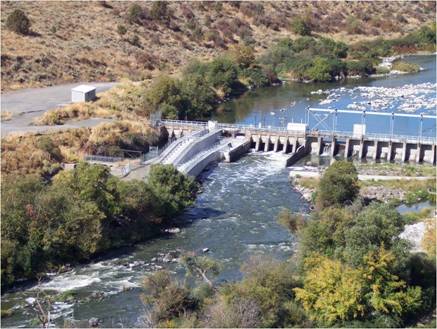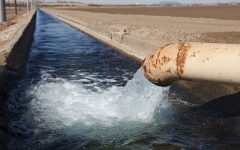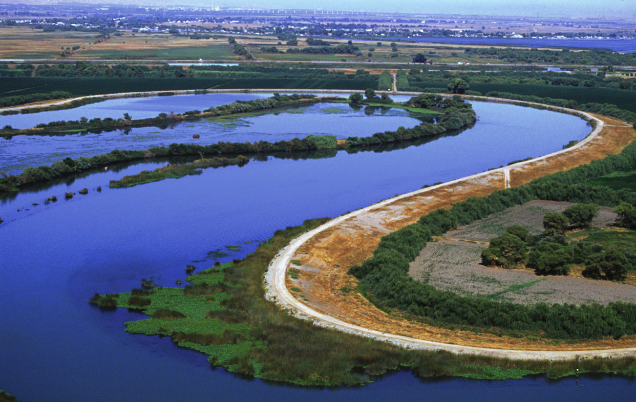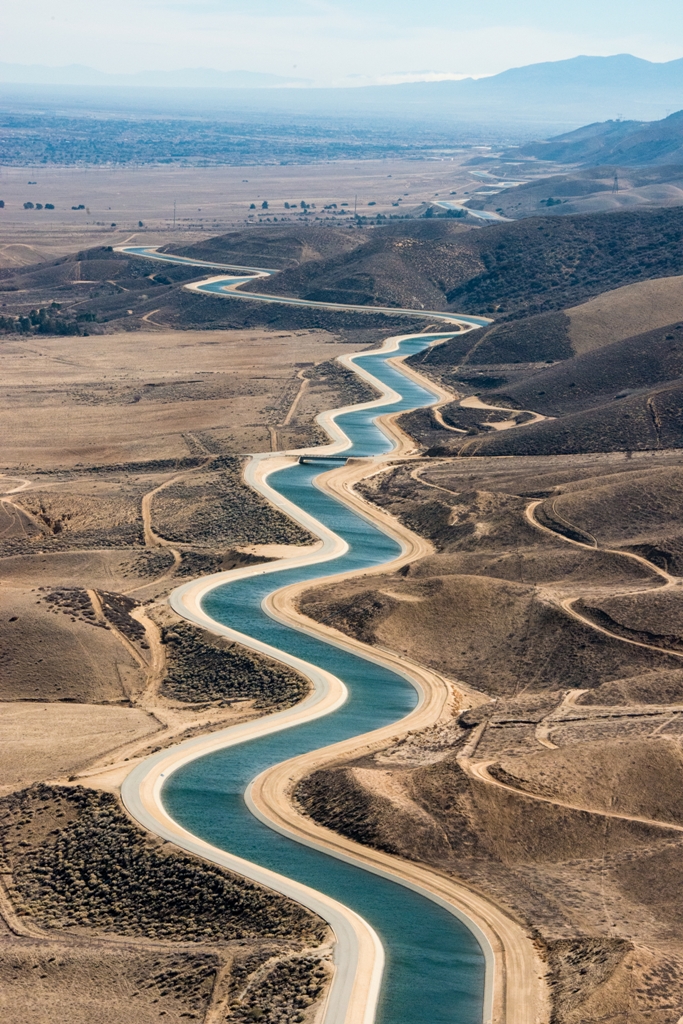
USBOR photo of Link River Dam and fish ladder. (Photo: fws.gov)
Ringside: AB 460 Hands Water Bureaucrats Even More Power
If the environmentalists who run Sacramento had held a gun to the heads of farming and ranching interests, it would have only been slightly more coercive
By Edward Ring, September 12, 2024 2:55 am
 Siskiyou and Modoc counties have a combined population of 52,700 people and combined area of 10,227 miles. That’s less than the population of Yucaipa in a territory the size of Massachusetts. It’s a big place with almost no political clout.
Siskiyou and Modoc counties have a combined population of 52,700 people and combined area of 10,227 miles. That’s less than the population of Yucaipa in a territory the size of Massachusetts. It’s a big place with almost no political clout.
That’s why back in August 2022 when a handful of desperate ranchers and farmers along the Shasta River defied the State Water Resources Control Board, hardly anyone noticed. But the people who did notice have inordinate clout in Sacramento.
The ranchers and farmers were backed into an impossible position. New regulations issued by the State Water Resources Control Board forbid them from withdrawing water from the Shasta River if summertime flow dropped below 50 cubic feet per second. This ruling came despite the fact that the 90 year average in that river in August has only been 38 CFS. After fruitless efforts to get the bureaucracy to relent, the ranchers and farmers were left with an existential choice: Let their crops and their cattle die, or pump water. For one lifesaving week, they pumped water. What would you have done?
The response was harsh. Led by Assemblywoman Rebecca Bauer-Kahan, last month the state legislature passed Assembly Bill 460 and sent it to Governor Newsom who is expected to sign it. From now on, as reported by CalMatters, anyone “violating curtailment orders could face fines of up to $10,000 per day – a 20-fold increase – plus $2,500 for every acre-foot of water taken.”
The implications for farmers everywhere in California are unsettling. For over a generation, the primary approach to habitat and species preservation in California’s rivers has been to increase the amount of “unimpaired flow,” even in summer when historically many rivers, certainly including the San Joaquin River and the Klamath River, would almost completely dry up. We need reservoirs to ensure summertime flows, but the implications of that irony are lost on our regulators.
To ensure more unimpaired flow, since 2000, the State Water Project has allocated 100 percent of their annual contracted deliveries to agriculture just once, in 2006. By contrast, from 1967 through 1999, farmers got 100 percent of their contracted water 27 out of 33 years.
Perhaps most unsettling, but all too typical, is how Assembly Bill 460 was rammed through the state legislature. Sources inside the Capitol said “the initial version of AB 460 would have made the bar for the board very low to stop people from diverting for an entire irrigation season and also would have stripped those diverters of due process and the ability to defend themselves.”
If the environmentalists who run Sacramento had held a gun to the heads of farming and ranching interests, it would have only been slightly more coercive.
Everyone wants to see California’s endangered fish species rebound. There are steps that could be taken to help revive salmon in the Klamath River without destroying the local farming and ranching industries up there, but apparently they aren’t politically palatable. Restore programs to encourage private hatchery boxes. Remediate the spawning grounds in the Salmon River that were destroyed in the floods of 1964. Cull the seals that congregate at the mouth of the river to feast on salmon returning to spawn. Experiment in the hatcheries with strains of salmon that are more resistant to hotter water.
To revive salmon down in the Sacramento-San Joaquin Delta, take away limits on bass fishing, like they’ve already done in Oregon.
These practices are necessary if we are serious about reviving the species. Instead our “experts” give cover for special interests that want to spend (and collect) billions for dam removals and a delta tunnel. As for farmers and ranchers, they’re collateral damage, and it’s just begun.
With mid-river dams on the Klamath gone, the environmentalists who want more “summertime flow” will go after the water in the Link River dam in the upper basin. Never mind that during times of high flow, water from the upper Klamath historically has flooded the Tule Basin upriver, and never made it downstream. Never mind that the water up there is needed to nurture wildlife habitat in Tule Lake and to refill aquifers that local farmers depend on for irrigation.
Farmers and ranchers in the Klamath Basin are hopelessly outgunned. Both counties combined only muster 32,796 registered voters, a miniscule 0.15 percent of California’s 22.2 million registered voters.
Farmers in the San Joaquin Valley have no cause for sanguinity. The number of registered voters in Fresno and Kern counties combined is only 952,325, a mere 4.3 percent of California’s total.
From a demographic standpoint, it is impossible for California’s farmers and ranchers to win a political fight. Their only hope is to convince the politicians, and the millions of urban voters who put them in office, that affordable food and abundant water are policy priorities that require the same level of concern that currently attend to fish.
- Ringside: Reversing California’s Policies of Scarcity - January 8, 2026
- Ringside: What is the Future of California’s Republican Party? - December 31, 2025
- Ringside: CA GOP Just Blew $46 Million for Nothing – Here’s How They Can Avoid Repeating That Mistake in 2026 - December 24, 2025





Many of us know all about Democrat Assemblywoman Rebecca Bauer-Kahan as the radical far-left environmental lawyer from the SF Bay Area who pushed Assembly Bill 2236 that bans any kind of plastic bags at food stores and convenience stores. Now she’s meddling in Siskiyou and Modoc counties and she wants to punish desperate ranchers and farmers along the Shasta River?
Democrat Assemblywoman Rebecca Bauer-Kahan lives in the ritzy San Francisco Bay Area city of Orinda and she represents the 16th State Assembly district which is the most affluent Assembly district in the state. She was raised Jewish and grew up pampered and privileged in the wealthy community of Portola Valley where the median income is well over $200,000. She’s a member of the California Legislative Jewish Caucus but she didn’t issue a peep when pro-Hamas thugs stormed the California State Capitol and shut down the Assembly session.
Instead she wants to ban plastic bags and punish struggling ranchers and farmers.
Maybe she’s getting payoffs from sketchy environmental groups that are funded by nefarious sources? Maybe she’s a member of the evil Khazarian Mafia?
Whatever, she’s truly evil?
The wealthy City of Orinda where Democrat Assemblywoman Rebecca Bauer-Kahan lives in her mansion gets 90 percent of their drinking water from snowmelt from the Sierra Nevada mountains via the Mokelumne River Watershed. That river pours into East Bay Municipal Utility District’s Pardee Reservoir in Valley Springs, California which is about a hundred miles away from the City of Orinda.
It’s ironic that an environmental lawyer like Democrat Assemblywoman Rebecca Bauer-Kahan wants punish struggling ranchers and farmers who live along the Shasta River but she has no problem with her wealthy city of Orinda stealing water from the the Mokelumne River Watershed that’s over a hundred miles away?
Democrat Assemblywoman Rebecca Bauer-Kahan is a shameless hypocrite?
(https://storymaps.arcgis.com/stories/3c8e00c52a6d4f9997967b0729fcb475)
The considerations of rural residents should get some consideration, but “political clout” should be measured in terms of number of people and voters, not acres owned. We have long moved on from land entitlement as a requirement for suffrage. Rural residents should not receive a disproportionate consideration over urban ones. Yet we spend more per capital on those rural citizens than on those in urban areas.
What kind of lamebrain logic is that? Rural residents like the ranchers and farmers in Siskiyou and Modoc counties are not being given ANY consideration even though nearby river and streams begin in the mountainous areas where they live. Meanwhile urban dwellers who mostly live in areas along the coast with limited fresh water sources are given hugely disproportionate consideration by having water delivered to them at great cost often from hundreds of miles away.
It’s time that urban dwellers who live in coastal areas like hypocritical Democrat Assemblywoman Rebecca Bauer-Kahan depend on the water sources in their area and quit stealing water from other areas of the state.
The wicked people running the CA State government have the agenda of limiting food production, single family homes, automobiles, and other bare necessities for a civilized society…they know exactly what they are doing and don’t care how much they harm their constituents, citizens of other areas of CA and ironically, the environment itself